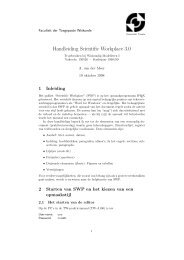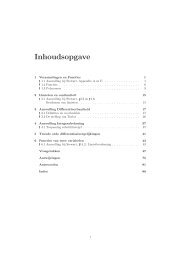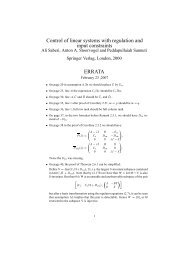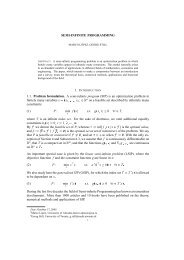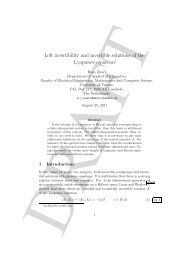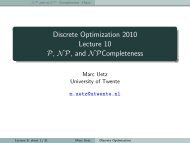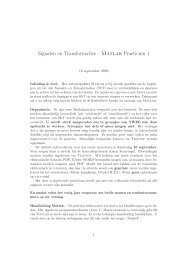Dispersion and dissipation error in high-order Runge-Kutta ...
Dispersion and dissipation error in high-order Runge-Kutta ...
Dispersion and dissipation error in high-order Runge-Kutta ...
Create successful ePaper yourself
Turn your PDF publications into a flip-book with our unique Google optimized e-Paper software.
5.2.1 One-dimensional Fourier analysis<br />
We are primarily <strong>in</strong>terested <strong>in</strong> wave propagation <strong>and</strong> <strong>in</strong> the associated dispersion <strong>and</strong><br />
<strong>dissipation</strong> <strong>error</strong> of the RKDG scheme. We consider the one-dimensional semi-discrete<br />
scheme (16)<br />
dq h<br />
dt<br />
= Aq h<br />
<strong>in</strong> the doma<strong>in</strong> Ω = [−1, 1] filled with vacuum (or air) <strong>and</strong> assume a monochromatic plane<br />
wave (which is also a Fourier mode)<br />
q h (0) = q 0 h = [ ]<br />
e ikx h<br />
, e ikx h T<br />
as <strong>in</strong>itial condition. Here, x h represents the vector of the nodes used for the spatial<br />
discretisation. We denote the angular wave frequency with ω. The exact wave number<br />
k is given by the dispersion relation k 2 = ω 2 /c 2 , with c be<strong>in</strong>g the speed of light. The<br />
time-exact discrete Fourier mode at time level t n = n∆t will read<br />
q h (n∆t) = ν n q h (0) = e −iωn∆t [ e ikx h<br />
, e ikx h] T<br />
(26)<br />
with exact amplification factor ν n = e −iωn∆t <strong>and</strong> i 2 = −1. To see the effect of the timestepp<strong>in</strong>g<br />
method, we replace the exact amplification factor ν n with its discrete counterpart<br />
νh n <strong>and</strong> take the fully discrete Fourier mode as<br />
q n h = νn h q0 h = νn h<br />
[ ]<br />
e<br />
ikx h<br />
, e ikx h T<br />
. (27)<br />
In addition, we write the SSP-RK scheme as a two-level explicit scheme. Thus<br />
q n+1<br />
h<br />
= Bq n h (28)<br />
holds with amplification matrix<br />
B =<br />
m∑<br />
l=0<br />
1<br />
l! (∆tA)l (29)<br />
<strong>and</strong> with m be<strong>in</strong>g the <strong>order</strong> of the SSP-RK time-stepp<strong>in</strong>g scheme. Substitut<strong>in</strong>g (27) <strong>in</strong>to<br />
(28) results <strong>in</strong> the equation<br />
[ ]<br />
ν n+1<br />
h e<br />
ikx h<br />
, e ikx h T [ ]<br />
= Bν<br />
n<br />
h e<br />
ikx h<br />
, e ikx h T<br />
,<br />
which, after division with νh n , reduce to the eigenvalue problem<br />
ν h q 0 h = Bq 0 h. (30)<br />
Solv<strong>in</strong>g this eigenvalue equation will produce p + 1 different values for ν h,j (<strong>and</strong> as many<br />
correspond<strong>in</strong>g eigenvectors q 0 h,j ). Bear<strong>in</strong>g <strong>in</strong> m<strong>in</strong>d that<br />
ν h,j = e −i˜ω h,j∆t ,<br />
12



